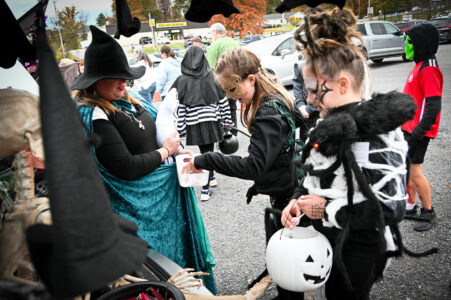WASD school board candidates answer questions about safety, fiscal outlook
The Sun-Gazette asked candidates for Williamsport Area School Board questions about school safety and about the fiscal outlook for education in Pennsylvania. Five of the candidates have responded:
Question One: School safety is an issue in the headlines, not only on the national level, but locally. Parents are concerned with the safety of their children and children are anxious about what is happening. How do you think school districts should approach this problem? What would you do to ensure the safety of children in the schools?
Nazirah Purnell: A graduate of the district said her goal is “work across the political divide to ensure all students have the opportunity to reach their highest potential.” She feels that as a mom, her son’s safety is always her highest concern. “Safety doesn’t rest on schools alone, it’s a shared responsibility among educators, families, and the community. The board should ensure everyone serving our students is fully trained on policies that keep our children safe and that accountability is upheld at the highest standard. Safety goes beyond physical security. It also means creating schools where students feel cared for, want to learn, and belong,” Purnell said.
Daniella Weaver: “To me, leadership means service. The School Board should advocate for all kids. I know what it takes to pay attention to complex details, meet people where they are, and keep the focus on the mission. Our schools are not a political battleground; they are a place for our community to raise our children together. Weaver feels that the district has made “clear changes” when it comes to school safety and security. “We improved training for emergencies and installed a new AI camera to watch for banned items. I support systems that work and focus on what’s in our control. New options keep coming, like devices to secure our classrooms. The Board should take charge of bringing in school safety solutions. These solutions can save lives and help our students feel safe.”
Lauren Montgomery: Feels the safety of students is a “top priority for our community and for the school board committee members.” Like other candidates she detailed some of the measures that have already been put on place. “As an elected school board member, I would continue to prioritize the physical safety of everyone on the WASD properties, and I would also promote transparent communication between the board and our community. Although knowing the ins and outs of school district decisions isn’t always possible, my desire is for parents and community members to feel informed about WASD’s budget, policies, and safety procedures by bridging the gap between the administration and the public,” Montgomery said.
Jamie Sanders: The only school board candidate who is seeking re-election, also talked about what the district has already done to ensure the safety of the students. He said that having already served he is “fairly aware of much of what we are doing, and I think some of the some of the events of the past year has allowed us to kind of focus on and hone in on some things that we could be doing better, although we were still doing a lot in the realms of safety, but those kind of things raise our awareness and allow us to kind of hone in on more programs and things that we can take advantage of and do so. I think awareness is a big issue of the threats that are coming in and the things that may happen.”
Taquila Lee: “I understand that student and school safety is a top priority, as parents and students expect secure environments. Since the 1960s, student safety has declined nationally, following rulings like Engel v. Vitale (1962) that banned school-sponsored prayer, with serious safety incidents rising from one or two per decade pre-1963 to 346 from 2021-2024, and 15-20% of students now facing threats like bullying, weapons, or disruptions annually, according to the National Center for Education Statistics and CDC.
As Founding Father and educator, Benjamin Rush declared, ‘Virtue is the soul of a republic… and the only means of perpetuating it is by a general diffusion of knowledge, tempered and directed by religion,’ reminding us that strong communities depend on moral character that fosters integrity, responsibility, respect– values that guide learning, build trust, and lays the foundation for safe schools.”
“Here in Williamsport, two recent safety breaches underscored this urgency. On September 25, 2024, a handgun and drugs were found in a 15-year-old student’s backpack at Williamsport Area High School, prompted by the odor of marijuana, leading to the student’s custody and increased police presence. Nine days later, on October 4, 2024, a hoax active shooter scare–caused by a student banging on a cafeteria door and yelling about being shot, amplified by social media threats–triggered mass panic, overturned tables, chaotic evacuations with injuries (e.g., falls down hills), and trauma. The administration’s delayed use of the Swift K-12 mass alert system left parents uninformed; the ALICE protocol (Alert, Lockdown, Inform, Counter, Evacuate) failed as students fled instead of locking down; and unchecked social media threats fueled the chaos.”
“To address these failures and restore safety, I propose: Prevention and Training … daily social media scans via Safe2Say expansions and AI tools like ZeroEyes and MagicSchool, funded through WASD Education Foundation (WASDEF) grants; … Improved communication … Swift K-12 is activated within five minutes of any alert, tested monthly with simulations. I also recommend implementing a unified messaging protocol: immediate “situation update” texts (e.g., “Fleeing reported; shelter in place”) followed by “all clear” with reunification details; … Community support and engagement … (partnering) with local faith leaders for a WASD-specific pilot initiative offering voluntary, opt-in counseling, de-escalation, and post-incident support.”
Question Two: Taxes and the cost of educating students. Pennsylvania taxpayers will spend $16.8 billion to educate K-12 students in the 2024-25 school year, at a cost of more than $21,985 per student, even though there are 39,000 fewer K-12 students in Pennsylvania’s public schools than in 2019-2020. Costs are increasing, The cost of maintaining aging buildings is increasing. Taxpayers, obviously, don’t want higher taxes, so what do you think is a way to deal with the high cost of educating children?
Purnell: “I believe our children deserve the best education possible and we can provide it while being fiscally responsible. It doesn’t have to be an either/or choice; we can and should pursue both. That means spending every dollar wisely to keep schools safe, support teachers, and fund opportunities for all students. Williamsport has already saved costs by closing outdated building (s) and reinvesting in facilities that make our district more attractive to families and strengthen our tax base. We must continue using taxpayer dollars with care and purpose.”
Weaver: Noted that the board has not increased taxes for the past four years. “I’m proud of our good management of our community’s investment in our schools. We should keep this trend going. Let’s only spend what we need to give our students the best education and use taxpayer money wisely,” she said.
Montgomery: Acknowledged that the board has overseen several improvements in the district without raising taxes, but also stated that ” while it is inevitable that taxes will go up at some point in the future, I believe their recent efforts show a value for caring for our children while remaining fiscally responsible..my desire is to support the school administration’s efforts to meet the needs of each student by investing in staff and technology that set them up for a positive future.”
Sanders: Also brought up the fact that taxes have not been raised in the district for the last four years. He then went on to stress that fiscal responsibility is the important thing in keeping taxes level. He also noted that during COVID when the district received ESSER funds, they had committed to investing that money wisely and coming out of that period stronger. Sanders did caution against people who are running for the board with a platform or agenda. “Many school board members run with a platform or an agenda. That’s not very helpful today. That’s not what I’m here to do, push a platform or an agenda. I’m here to be a watchdog for the community and to be a sounding board for the community and for the school board with the needs of the community as far as the students go and the safety and financial issues that we’ve been discussing, to kind of be a go between approve some of those decisions that come to a vote for us. But I think it’s not helpful to push an agenda. It’s helpful to come and be a team player and learn the role and then see where you fit in.”
Lee: “With Pennsylvania’s $16.8 billion K-12 budget ($21,985 per student) in 2024-25, despite a 39,000-student decline since 2019-2020, and WASD’s inability to consolidate schools further, cost management is critical. The 2024-25 state budget’s $1.1 billion increase ($526 million for adequacy gaps, $225 million via Basic Education Funding) supports WASD’s no-tax-increase stance (17.24 millage rate). To maintain fiscal responsibility, I propose: 1. Budget Optimization: WASD has avoided tax hikes for four years. I recommend we push for transparent, third-party audits of contracts, energy use, and administrative roles to redirect funds to safety and instruction. 2. Public-Private Partnerships: WASD Education Foundation’s (WASDEF) $67,000+ in 2024 grants is a model. I will expand partnerships with local businesses to support technology and infrastructure. 3. Preventive Maintenance: WASD bids for upkeep (e.g., $68,602 for blacktop) prevent costly repairs. I will advocate for energy-efficient upgrades to reduce costs. 4. Grant Pursuit: WASD secures significant grants through WASDEF. I recommend we streamline WASDEF’s volunteer-led process with staff training and expanded community partnerships to maximize state, federal, and private funding for safety and infrastructure, avoiding new hires to keep costs low. 5. Funding Advocacy: Building on the Pennsylvania School Boards Association’s efforts to refine the state funding formula for equity and adequacy, I will advocate alongside peers to ensure WASD receives resources reflecting enrollment declines and local needs, maintaining fiscal responsibility without tax increases. These strategies will enhance WASD’s fiscal discipline, maintaining educational quality while addressing taxpayer concerns. I am dedicated to making Williamsport Area School District a safe, accountable, and financially responsible district, partnering with families to inspire student excellence through values-driven, learning-focused education.”


